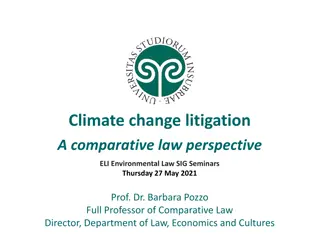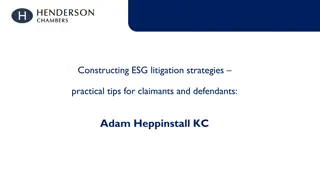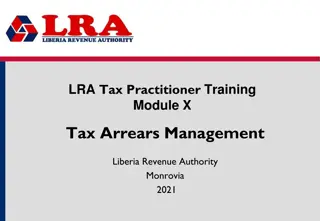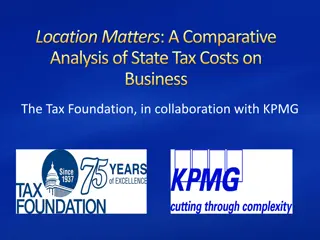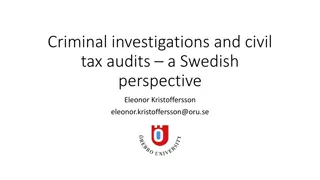Essential Litigation Management for Tax Officers
Essential role of litigation management in handling income tax law disputes, including the importance of robust case management, supervisory quality, training, and coordination with courts for speedy disposal. Emphasizes the key role of knowledgeable assessing officers in defending and applying the law effectively.
Download Presentation

Please find below an Image/Link to download the presentation.
The content on the website is provided AS IS for your information and personal use only. It may not be sold, licensed, or shared on other websites without obtaining consent from the author.If you encounter any issues during the download, it is possible that the publisher has removed the file from their server.
You are allowed to download the files provided on this website for personal or commercial use, subject to the condition that they are used lawfully. All files are the property of their respective owners.
The content on the website is provided AS IS for your information and personal use only. It may not be sold, licensed, or shared on other websites without obtaining consent from the author.
E N D
Presentation Transcript
Critical Path and Gantt Project Schedule/Time Management Chapter 8
Gantt Charts Gantt charts provide a standard format for displaying project schedule information by listing project activities and their corresponding start and finish dates in a calendar format Symbols include: A black diamond: a milestones Thick black bars: summary tasks Lighter horizontal bars: durations of tasks Arrows: dependencies between tasks
Adding Milestones to Gantt Charts Many people like to focus on meeting milestones, especially for large projects Milestones emphasize important events or accomplishments on projects Normally create milestone by entering tasks with a zero duration, or you can mark any task as a milestone
SMART Criteria Milestones should be Specific Measurable Assignable Realistic Time-framed
Best Practice Schedule risk is inherent in the development of complex systems. Luc Richard, the founder of www.projectmangler.com, suggests that project managers can reduce schedule risk through project milestones, a best practice that involves identifying and tracking significant points or achievements in the project. The five key points of using project milestones include the following: 1. Define milestones early in the project and include them in the Gantt chart to provide a visual guide 2. Keep milestones small and frequent 3. The set of milestones must be all-encompassing 4. Each milestone must be binary, meaning it is either complete or incomplete. 5. Carefully monitor the critical path
Critical Path Method (CPM) CPM is a network diagramming technique used to predict total project duration A critical path for a project is the series of activities that determines the earliest time by which the project can be completed The critical path is the longest path through the network diagram and has the least amount of slack or float Slack or float is the amount of time an activity may be delayed without delaying a succeeding activity or the project finish date
Calculating the Critical Path First develop a good network diagram Add the duration estimates for all activities on each path through the network diagram The longest path is the critical path If one or more of the activities on the critical path takes longer than planned, the whole project schedule will slip unless the project manager takes corrective action
More on the Critical Path A project team at Apple computer put a stuffed gorilla on the top of the cubicle of the person currently managing critical task The critical path is not the one with all the critical activities; it only accounts for time Remember the example of growing grass being on the critical path for Disney s Animal Kingdom There can be more than one critical path if the lengths of two or more paths are the same The critical path can change as the project progresses
Using Critical Path Analysis to Make Schedule Trade-offs Free slack or free float is the amount of time an activity can be delayed without delaying the early start of any immediately following activities Total slack or total float is the amount of time an activity may be delayed from its early start without delaying the planned project finish date A forward pass through the network diagram determines the early start and finish dates A backward pass determines the late start and finish dates
Using the Critical Path to Shorten a Project Schedule Three main techniques for shortening schedules Shortening durations of critical activities/tasks by adding more resources or changing their scope Crashing activities by obtaining the greatest amount of schedule compression for the least incremental cost Fast tracking activities by doing them in parallel or overlapping them
Importance of Updating Critical Path Data It is important to update project schedule information to meet time goals for a project The critical path may change as you enter actual start and finish dates If you know the project completion date will slip, negotiate with the project sponsor
Critical Chain Scheduling Critical chain scheduling a method of scheduling that considers limited resources when creating a project schedule and includes buffers to protect the project completion date Uses the Theory of Constraints (TOC) a management philosophy developed by Eliyahu M. Goldratt and introduced in his book The Goal. Attempts to minimize multitasking when a resource works on more than one task at a time 18
Buffers and Critical Chain A buffer is additional time to complete a task Murphy s Law states that if something can go wrong, it will Parkinson s Law states that work expands to fill the time allowed In traditional estimates, people often add a buffer to each task and use it if it s needed or not Critical chain scheduling removes buffers from individual tasks and instead creates a project bufferor additional time added before the project s due date feeding buffers or additional time added before tasks on the critical path



![Town of [Town Name] Real Estate Tax Rates and FY 2024 Budget Summary](/thumb/62211/town-of-town-name-real-estate-tax-rates-and-fy-2024-budget-summary.jpg)
